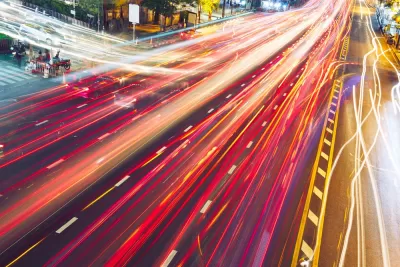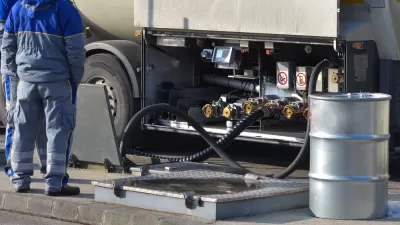Op-ed: Charging road users by how much they drive, not how much gas they buy, is the only sustainable way forward for infrastructure funding.

Earlier this year, President Biden called for electrifying the entire federal vehicle fleet — about 645,000 passenger cars, trucks and vans — putting the nation on track to a green energy transportation future.
General Motors followed shortly after, announcing plans to only produce all-electric vehicles (EVs) by 2035. Several other major automakers either plan to or have already produced EV models, joining Tesla, which has dominated the market for over a decade.
That’s the good news. The bad news? We need to find a way to pay for the repair and maintenance of our roads, bridges and public transit—which all rely in part on gas tax revenues—once we fully transition away from gas-powered vehicles.
Demand for EVs in the U.S. is expected to grow, accounting for a projected 7.6 percent of the passenger car market in 2026, up from just 1.2 percent in 2018. While new EVs are more expensive than conventional vehicles, prices will fall as they become less costly to produce. Federal and state governments also offer a range of consumer incentives such as tax credits, cash rebates and reduced registration fees to boost sales.
In addition to becoming more affordable to purchase, demand for EVs is certain to rise further as drivers become more aware of the money they could save on fuel and routine maintenance.
The growing demand for EVs and U.S. automakers’ production decisions may also reflect a shift in attitude on climate change among Americans. A Pew poll last year found that almost two-thirds of Americans said that protecting the environment should be a priority for the federal government compared to 41 percent in 2008. EV adoption will go a long way towards reducing environmentally harmful carbon emissions, as transportation accounts for almost a third of total emissions, the largest share of any economic sector in the U.S.
But as more drivers ditch their combustion engine cars for the electric equivalent, concerns are rising that revenues in the Highway Trust Fund, a dedicated source of money from the federal gas tax charged at the pump, will further erode. Because the tax has not been raised since 1993 and fuel efficient vehicles have increased in popularity, there has been a growing gap between the money needed to maintain our roads and the amount raised through the Fund. Since 2008, Congress has had to rely on annual transfers from non-dedicated revenue sources to prevent the Highway Trust Fund from running out of money.
With the gas tax becoming more unreliable as a revenue source and EVs on the horizon, most experts now agree that something needs to be done: the question is, what?
FULL STORY: Gas Taxes Pay For Our Roads. What Happens When Cars Go Electric?

Planetizen Federal Action Tracker
A weekly monitor of how Trump’s orders and actions are impacting planners and planning in America.

Congressman Proposes Bill to Rename DC Metro “Trump Train”
The Make Autorail Great Again Act would withhold federal funding to the system until the Washington Metropolitan Area Transit Authority (WMATA), rebrands as the Washington Metropolitan Authority for Greater Access (WMAGA).

DARTSpace Platform Streamlines Dallas TOD Application Process
The Dallas transit agency hopes a shorter permitting timeline will boost transit-oriented development around rail stations.

New Jersey Duplexes Elicit Mixed Reactions
Modern, two-unit residences are proliferating in northern New Jersey communities, signaling for some a boon to the housing supply and to others a loss of historic architecture.

Renters Now Outnumber Homeowners in Over 200 US Suburbs
High housing costs in city centers and the new-found flexibility offered by remote work are pushing more renters to suburban areas.

The Tiny, Adorable $7,000 Car Turning Japan Onto EVs
The single seat Mibot charges from a regular plug as quickly as an iPad, and is about half the price of an average EV.
Urban Design for Planners 1: Software Tools
This six-course series explores essential urban design concepts using open source software and equips planners with the tools they need to participate fully in the urban design process.
Planning for Universal Design
Learn the tools for implementing Universal Design in planning regulations.
Municipality of Princeton
Roanoke Valley-Alleghany Regional Commission
City of Mt Shasta
City of Camden Redevelopment Agency
City of Astoria
Transportation Research & Education Center (TREC) at Portland State University
US High Speed Rail Association
City of Camden Redevelopment Agency
Municipality of Princeton (NJ)




























